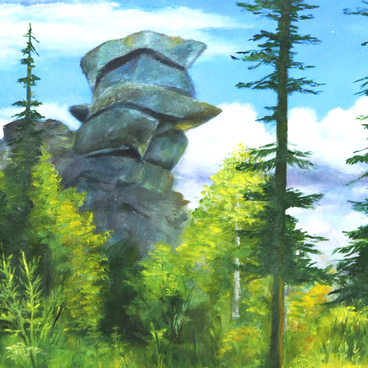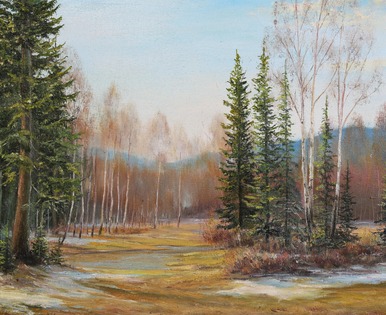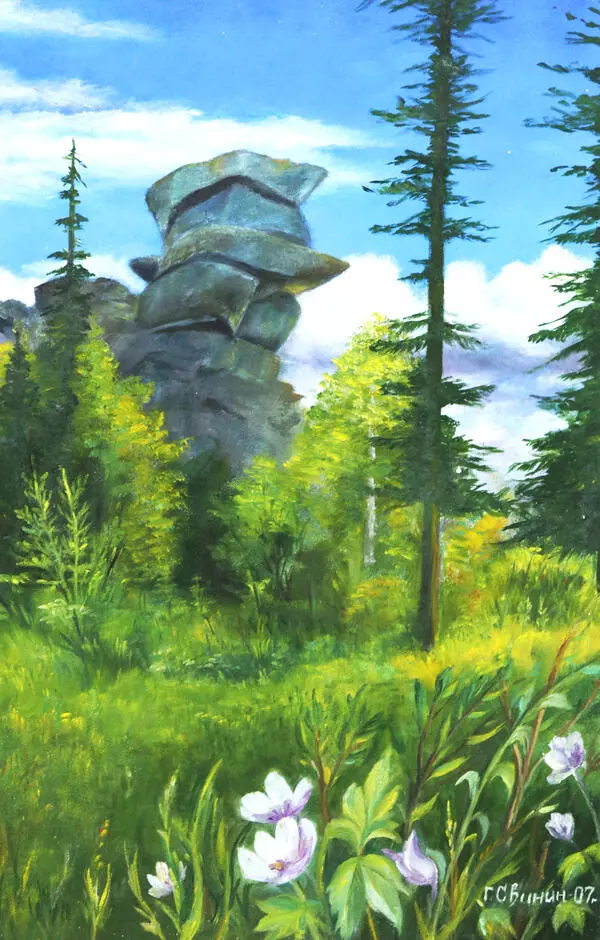Gennady Egorovich Svinin is a highly original artist -a talented painter with a special gift for landscapes. He was born in the Russian Far East. He graduated from Tomsk Polytechnical Institute. In 1971 he moved to the Kuzbass region. He spent his entire career working in the coal industry. When he retired, he continued to work for Yuzhny Kuzbass as the company’s senior mine surveyor. Gennady Svinin also dedicated more than 20 years to painting. The artist celebrated his native region in his art. In his works he expresses his love for the beauty of Siberia’s nature. His canvases depict scenes that resonate with the viewer — graceful birches, mountain lakes and ancient cedar trees under an intense blue sky. His remarkable landscape paintings are filled with radiant sunlight, and dominated by warm, saturated tones that are full of life. His palette is remarkably rich in color, and conveys a sense of warmth and tenderness.
His painting Village Landscape depicts a small village in winter, nestled among the picturesque expanses of the Mountain Shoria region. In the foreground we see a road, and the recent tracks of a horse-drawn cart bearing hay. On the edge of this open space there is a forest. On the horizon are there is a wall of snow-covered mountains. In the middle ground of the picture there are wooden buildings and a haystack, all covered with snow.
The use of color creates a fairytale atmosphere. The soft technique and the muted colors — the combination of ochres, blues, greens, greys and whites — convey the feeling of a calm and sunny winter day.
The artist depicts a typical landscape of Mountain Shoria. The Kuznetsk Tatars have long lived in its plains. The native Shorians initially built two different types of buildings by the tributaries of rivers: odags — a kind of wooden hut made of planks and poles, and low, rectangular timber-framed yurts. Later on, Russian-style log huts appeared, and these almost completely replaced the yurts. Around the huts various farm buildings were constructed out of logs.
The local people generally did not have many farm animals. In winter, when the ground was covered with a thick layer of snow, it was necessary to have a store of hay, so they used haystacks. In the winter the farm animals were driven towards the haystacks, where they were allowed to eat.
In the picture the artist has painted a crane in the courtyard of one of the houses. That is the name for a well with a very specific lifting mechanism consisting of a thick pole (the crane) fixed to a wooden board (the pivot) above the well, with a bucket or chain at one end and a weigh on the other.
This type of well mechanism is known as a crane, because it resembles the bird of the same name. It dates back to ancient times — lifting devices of this type, called shadoofs, were used by the Egyptians to water their fields as early as the 4th millennium BC.
Gennady Svinin’s work allows us to imagine the life of the inhabitants of rural Mountain Shoria.
His painting Village Landscape depicts a small village in winter, nestled among the picturesque expanses of the Mountain Shoria region. In the foreground we see a road, and the recent tracks of a horse-drawn cart bearing hay. On the edge of this open space there is a forest. On the horizon are there is a wall of snow-covered mountains. In the middle ground of the picture there are wooden buildings and a haystack, all covered with snow.
The use of color creates a fairytale atmosphere. The soft technique and the muted colors — the combination of ochres, blues, greens, greys and whites — convey the feeling of a calm and sunny winter day.
The artist depicts a typical landscape of Mountain Shoria. The Kuznetsk Tatars have long lived in its plains. The native Shorians initially built two different types of buildings by the tributaries of rivers: odags — a kind of wooden hut made of planks and poles, and low, rectangular timber-framed yurts. Later on, Russian-style log huts appeared, and these almost completely replaced the yurts. Around the huts various farm buildings were constructed out of logs.
The local people generally did not have many farm animals. In winter, when the ground was covered with a thick layer of snow, it was necessary to have a store of hay, so they used haystacks. In the winter the farm animals were driven towards the haystacks, where they were allowed to eat.
In the picture the artist has painted a crane in the courtyard of one of the houses. That is the name for a well with a very specific lifting mechanism consisting of a thick pole (the crane) fixed to a wooden board (the pivot) above the well, with a bucket or chain at one end and a weigh on the other.
This type of well mechanism is known as a crane, because it resembles the bird of the same name. It dates back to ancient times — lifting devices of this type, called shadoofs, were used by the Egyptians to water their fields as early as the 4th millennium BC.
Gennady Svinin’s work allows us to imagine the life of the inhabitants of rural Mountain Shoria.




